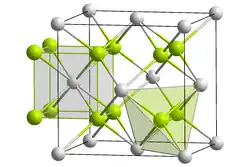 | |
| Names | |
|---|---|
| IUPAC name
Praseodymium(IV) oxide | |
| Identifiers | |
3D model (JSmol) |
|
| ChemSpider | |
| ECHA InfoCard | 100.031.658 |
| EC Number |
|
PubChem CID |
|
CompTox Dashboard (EPA) |
|
| |
| |
| Properties | |
| PrO2 | |
| Molar mass | 172.91 |
| Appearance | Dark brownish crystal[1] |
| Structure[2] | |
| Fluorite structure | |
| Fm3m (No. 225) | |
a = 539.3 pm | |
Formula units (Z) |
4 |
| Related compounds | |
Related compounds |
Praseodymium(III) oxide Praseodymium(III,IV) oxide |
Except where otherwise noted, data are given for materials in their standard state (at 25 °C [77 °F], 100 kPa).
Infobox references | |
Praseodymium(IV) oxide is an inorganic compound with chemical formula PrO2.
Production
Praseodymium(IV) oxide can be produced by boiling Pr6O11 in water or acetic acid:[1]
- Pr6O11 + 3 H2O → 4 PrO2 + 2 Pr(OH)3
Chemical reactions
Praseodymium(IV) oxide starts to decompose at 320~360 °C, liberating oxygen.
References
- 1 2 Chinese: 《无机化学丛书》.第七卷 钪 稀土元素. 科学出版社. 1.3.4 氧化态+4的化合物. P193~195
- ↑ Kern, Sanford (1964). "Magnetic Susceptibility of Praseodymium Oxides". The Journal of Chemical Physics. AIP Publishing. 40 (1): 208–212. Bibcode:1964JChPh..40..208K. doi:10.1063/1.1724864. ISSN 0021-9606.
This article is issued from Wikipedia. The text is licensed under Creative Commons - Attribution - Sharealike. Additional terms may apply for the media files.